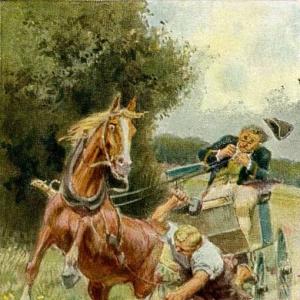Reading time: 7 min
There lived once a great queen, in whose garden were found at all seasons the most splendid flowers, and from every land in the world. She specially loved roses, and therefore she possessed the most beautiful varieties of this flower, from the wild hedge-rose, with its apple-scented leaves, to the splendid Provence rose. They grew near the shelter of the walls, wound themselves round columns and window-frames, crept along passages and over the ceilings of the halls. They were of every fragrance and color.
But care and sorrow dwelt within these halls. The queen lay upon a sick bed, and the doctors declared that she must die. „There is still one thing that could save her,“ said one of the wisest among them. „Bring her the loveliest rose in the world. One which exhibits the purest and brightest love, and if it is brought to her before her eyes close, she will not die.“
Then from all parts came those who brought roses that bloomed in every garden, but they were not the right sort. The flower must be one from the garden of love; but which of the roses there showed forth the highest and purest love? The poets sang of this rose, the loveliest in the world, and each named one which he considered worthy of that title; and intelligence of what was required was sent far and wide to every heart that beat with love; to every class, age, and condition.
„No one has yet named the flower,“ said the wise man. „No one has pointed out the spot where it blooms in all its splendor. It is not a rose from the coffin of Romeo and Juliet, or from the grave of Walburg, though these roses will live in everlasting song. It is not one of the roses which sprouted forth from the blood-stained fame of Winkelreid. The blood which flows from the breast of a hero who dies for his country is sacred, and his memory is sweet, and no rose can be redder than the blood which flows from his veins. Neither is it the magic flower of Science, to obtain which wondrous flower a man devotes many an hour of his fresh young life in sleepless nights, in a lonely chamber.“
„I know where it blooms,“ said a happy mother, who came with her lovely child to the bedside of the queen. „I know where the loveliest rose in the world is. It is seen on the blooming cheeks of my sweet child, when it expresses the pure and holy love of infancy. When refreshed by sleep it opens its eyes, and smiles upon me with childlike affection.“
„This is a lovely rose,“ said the wise man. „But there is one still more lovely.“
„Yes, one far more lovely,“ said one of the women. „I have seen it, and a loftier and purer rose does not bloom. But it was white, like the leaves of a blush-rose. I saw it on the cheeks of the queen. She had taken off her golden crown, and through the long, dreary night, she carried her sick child in her arms. She wept over it, kissed it, and prayed for it as only a mother can pray in that hour of her anguish.“
„Holy and wonderful in its might is the white rose of grief, but it is not the one we seek.“
„No. The loveliest rose in the world I saw at the Lord’s table,“ said the good old bishop. „I saw it shine as if an angel’s face had appeared. A young maiden knelt at the altar, and renewed the vows made at her baptism; and there were white roses and red roses on the blushing cheeks of that young girl. She looked up to heaven with all the purity and love of her young spirit, in all the expression of the highest and purest love.“
„May she be blessed!“ said the wise man: „but no one has yet named the loveliest rose in the world.“
Then there came into the room a child– the queen’s little son. Tears stood in his eyes, and glistened on his cheeks. He carried a great book and the binding was of velvet, with silver clasps. „Mother,“ cried the little boy; „only hear what I have read.“ And the child seated himself by the bedside, and read from the book of Him who suffered death on the cross to save all men, even who are yet unborn. He read, „Greater love hath no man than this,“ and as he read a roseate hue spread over the cheeks of the queen, and her eyes became so enlightened and clear, that she saw from the leaves of the book a lovely rose spring forth, a type of Him who shed His blood on the cross.
„I see it,“ she said. „He who beholds this, the loveliest rose on earth, shall never die.“
 Learn languages. Double-tap on a word.Learn languages in context with Childstories.org and Deepl.com.
Learn languages. Double-tap on a word.Learn languages in context with Childstories.org and Deepl.com.Backgrounds
Interpretations
Adaptions
Summary
Linguistics
„The Loveliest Rose in the World“ is a fairy tale written by Danish author Hans Christian Andersen. Born in 1805 in Odense, Denmark, Andersen was a prolific writer and poet, best known for his fairy tales. His stories have been translated into many languages and have become a significant part of children’s literature worldwide.
Andersen’s fairy tales often contain moral lessons, exploring themes such as love, sacrifice, and human nature. While many of his stories have happy endings, some also explore darker themes and have more somber conclusions. His writing style is characterized by a combination of realism, fantasy, and lyrical prose.
Some of his most famous works include „The Little Mermaid,“ „The Ugly Duckling,“ „The Emperor’s New Clothes,“ and „The Snow Queen.“ Andersen’s stories have inspired numerous adaptations, such as ballets, plays, animated films, and live-action movies.
„The Loveliest Rose in the World“ is one of Andersen’s lesser-known tales, but it shares many of the characteristics of his more famous works. It explores themes of love, faith, and the power of storytelling, while incorporating elements of fantasy and the search for truth. The story showcases Andersen’s ability to convey meaningful messages through engaging and imaginative narratives.
„The Loveliest Rose in the World“ by Hans Christian Andersen presents several interpretations and themes that can be derived from the story:
The power of love: The story emphasizes the importance of love, particularly its ability to heal and uplift. The loveliest rose symbolizes the purest and brightest form of love, which has the power to save the queen from death. The tale demonstrates that love comes in various forms, such as a mother’s love for her child, the grief experienced by the queen, and the love and devotion of a young maiden.
Spiritual love and salvation: The loveliest rose is ultimately revealed as the love of Jesus, who sacrificed his life on the cross for humanity. This spiritual love transcends earthly love and offers salvation and eternal life to those who embrace it. The story suggests that spiritual love is the highest and purest form of love, and that faith can bring hope and healing even in the darkest moments.
The search for meaning and truth: Throughout the story, characters present their interpretations of the loveliest rose, revealing their values and experiences. The search for the loveliest rose becomes a quest for understanding the true meaning of love and its power. Each person’s perspective contributes to a broader understanding of love, culminating in the revelation of spiritual love as the ultimate expression of devotion and sacrifice.
The transformative power of stories: The queen’s son reads a passage from a book about Jesus‘ sacrifice, and this act of storytelling leads to the queen’s recovery. The story highlights the power of stories to inspire, enlighten, and transform people’s lives, as well as their ability to convey important lessons and values.
„The Loveliest Rose in the World“ by Hans Christian Andersen has been adapted into various forms of media over the years. Here are some notable adaptations:
Theater: The story has been adapted into stage plays, including a musical adaptation by composer Nicolai Abildgaard.
Opera: In 1992, composer John Metcalf and librettist Heather Spears adapted the story into an opera called „The Loveliest Rose in the World.“
Television: The story has been adapted into animated television specials, including a 1974 adaptation by Rankin/Bass Productions.
Literature: The story has been retold in various forms of literature, including a children’s book adaptation by Danish author Joan D. Vinge.
Film: In 2011, the story was adapted into a short film by director Matthew L. Schaffer.
Art: The story has been illustrated by numerous artists, including Edmund Dulac, who created a series of beautiful illustrations for the story in 1911.
Overall, „The Loveliest Rose in the World“ has inspired many artists and creators to adapt the story into different forms of media. These adaptations have helped to keep the story alive and popular among audiences of all ages.
„The Loveliest Rose in the World“ by Hans Christian Andersen tells the story of a great queen who adores roses and has a garden filled with the most beautiful varieties. The queen falls gravely ill, and the doctors announce that only the loveliest rose in the world, symbolizing the purest and brightest love, can save her.
People from all over bring roses from their gardens, but none are the right one. The loveliest rose must come from the garden of love. Poets sing about it, and many claim to know the location of the flower, but none are correct. The wise man clarifies that it isn’t the rose of any famous love story, a hero’s sacrifice, or the flower of science.
A mother believes the loveliest rose is the love on her child’s cheeks, but the wise man says there’s an even lovelier rose. A woman shares her encounter with the queen’s white rose of grief, but it is still not the one they seek. A bishop speaks of the rose he saw on a young maiden’s cheeks as she prayed, but that too is not the loveliest rose.
The queen’s son enters the room, carrying a book about Jesus‘ sacrifice on the cross. As he reads about the greatest love, a roseate hue spreads over the queen’s cheeks, and she sees a lovely rose spring from the book’s pages, symbolizing the love of Jesus. The queen declares that whoever beholds this loveliest rose on earth shall never die.
Hans Christian Andersen’s „The Loveliest Rose in the World“ is a fairy tale that explores themes of love, sacrifice, and spiritual devotion through a linguistic lens. The tale is rich in metaphorical language and symbolism, contributing to a deeper understanding of its message.
Symbolism and Themes
The Rose as a Symbol of Love: The central symbol in the story is the rose, representing pure and true love. This sets an archetypal quest as the characters search for „the loveliest rose,“ which metaphorically stands for the highest form of love.
Different Forms of Love: The story explores various forms of love—maternal love, selfless sacrifice, romantic love, and divine love. Each is personified through different characters attempting to offer their version of the „loveliest rose. “
Christian Imagery: The narrative culminates in the depiction of divine love, with explicit Christian imagery. The child’s reading from the Bible introduces Christ’s sacrificial love as the ultimate “loveliest rose,” a symbol that transcends all worldly love.
Descriptive Language: Andersen uses vivid descriptions to bring the garden and roses to life. Phrases such as “apple-scented leaves” and „blooming cheeks“ evoke the senses and create a connection between the natural beauty of the roses and human emotions.
Dialogues: The dialogues, especially those of the wise man, woman, and bishop, are layered and serve to express the multifaceted nature of love. Each character represents a different perspective, emphasizing that love is interpreted through various lenses in life.
Symbolic Characters: Each character, from the happy mother to the bishop, embodies a distinct aspect of love. Their contributions are linguistically aligned with their roles, reinforcing their symbolic significances.
Metaphor and Allegory: The search for the loveliest rose acts as an allegory for the quest for true spiritual enlightenment. Anderson uses metaphor to elevate the narrative from a simple quest to a deeper philosophical exploration of love.
Structure and Development
Narrative Progression: The narrative structure follows a classic quest format, with each attempt to find the rose bringing the queen closer to understanding the nature of true love.
Resolution with Divine Understanding: The child’s reading provides an epiphany, revealing that true love is sacrificial and divine. The structure peaks here as the queen gains spiritual insight, healing not only her body but also her soul.
Conclusion
In „The Loveliest Rose in the World,“ Andersen masterfully weaves a tapestry of symbols and linguistic richness to explore the nature of love. The tale encourages readers to consider love beyond its earthly expressions, urging a recognition of selfless, divine love as the epitome of beauty and purity. Through the use of symbolism, dialogue, and metaphorical language, Andersen elevates a simple fairy tale into a profound philosophical narrative.
Information for scientific analysis
Fairy tale statistics | Value |
|---|---|
| Translations | DE, EN, DA, ES, NL |
| Readability Index by Björnsson | 27.4 |
| Flesch-Reading-Ease Index | 82.6 |
| Flesch–Kincaid Grade-Level | 6.2 |
| Gunning Fog Index | 8.7 |
| Coleman–Liau Index | 7.9 |
| SMOG Index | 8.2 |
| Automated Readability Index | 6.5 |
| Character Count | 4.339 |
| Letter Count | 3.326 |
| Sentence Count | 46 |
| Word Count | 826 |
| Average Words per Sentence | 17,96 |
| Words with more than 6 letters | 78 |
| Percentage of long words | 9.4% |
| Number of Syllables | 1.035 |
| Average Syllables per Word | 1,25 |
| Words with three Syllables | 35 |
| Percentage Words with three Syllables | 4.2% |

 Facebook
Facebook  Whatsapp
Whatsapp  Messenger
Messenger  Telegram
Telegram Reddit
Reddit













